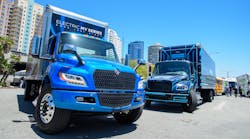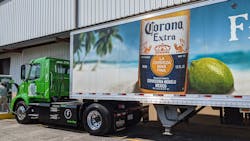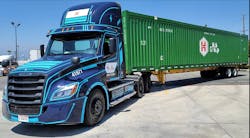More fleets are seeking decarbonization solutions from truckmakers than ever before. While sustainability-aimed regulations drove some early development of battery-electric trucks, the industry is taking more control of its future.
“For battery-electric vehicles, there is a customer demand already,” according to Michael Grahe, EVP of operations at Navistar. “We see it in the sustainability goals set by customers to eliminate emissions from supply chains. We see it in today’s conscious customers who are supporting CO2-conscious companies with their dollars. This will not be a regulatory-driven change—this will be a customer-driven change.”
Grahe joined two other North American OEM executives to share their views on future transport technology during Endeavor Business Media’s virtual CV Tech Conference, led by FleetOwner and other Commercial Vehicle Group editors, on June 7.
Now available: 2022 Commercial Electric Vehicle Adoption Report
“Innovation and change have always been part of the commercial vehicle industry,” Grahe said. “But with the shift to zero-emission powertrains, connected vehicles, and autonomous driving, we are at hyperspeed of change.”
New believers in decarbonization
Recent advancements in CV technology are creating new believers in a decarbonized trucking industry. “Five or six years ago, I was a doubting Thomas on whether or not this could really work in the North American application,” said Keith Brandis, VP of system solutions and partnerships for North America at Volvo Group, which produces Volvo and Mack Trucks.
“We are both in exciting and historic times,” Brandis said. “I don’t think we’ve seen this level of technology change since diesel engines replaced gas in the ’50s and turbocharging in the ’60s.”
It’s not just about more battery-electric trucks, he said. Over the next 10 years, Brandis expects to see hydrogen fuel-cell technology emerge along with bio- and fossil-free fuels to power internal combustion engines.
How fast the industry transitions to zero-emission trucking is still uncertain, according to David Carson, SVP of sales and marketing at Daimler Truck North America, which makes Freightliner and Western Star Trucks.
See also: Adding new technology requires driver buy-in, communication
“We know that diesel is critically important for certain applications that just can’t be electrified immediately—or it’s difficult for payload or range,” Carson said during CV Tech. “So clean diesel and clean-diesel technology are really going to be a continued part of our propulsion strategy.
“We're not just investing in battery-electric, we're investing in fuel-cell development—that's maybe a little bit further off timewise, but maybe by the end of the decade,” Carson continued. “We have products in place that are better suited for long-haul applications and really provide that range that our customers are accustomed to today with diesel propulsion.”
For fleets, Carson added, new technology adoption comes down to total cost of ownership. Early zero-emission transitions need incentives to make it work financially. “It’s a process for sure—you have to start somewhere,” he noted. “And we’re confident we’re off to a good start in that regard.”
Navistar, which makes International Trucks and IC Buses, has seen early shifts toward EVs with medium-duty city delivery trucks and school buses, Grahe said. The next zero-emission focus will be on regional haul, followed by long haul.
“The total cost of ownership is the tipping point,” Grahe said. “Cost parity between electric and diesel will be the primary driver to higher adoption of zero-emission technologies. And this will happen faster than many people expect. We see in all major segments that disparity is reached within the timeframe of 2025. So this is basically tomorrow.”
Start fleet EV planning early
All three executives noted how the OEMs work with fleets to plan for this quickly approaching future.
Brandis said Volvo takes “a market-by-market approach” to help fleets begin zero-emission adoption. “Incentives are an important part of offsetting the higher capital costs of these initial vehicles,” he said. “We are working with both the federal government and state and local governments to see if we can accelerate the incentives necessary not only for the purchase of the vehicle—but also the infrastructure.”
See also: Helping fleets get to a greener future
Government and utility incentives over the coming years will be needed to help keep TCO down and drive EV adoption and rollouts, Brandis explained. “Not every state has a cap and trade program similar to California,” he said. “So we have to really look at the localities where these trucks are designed to be delivered.”
During the Volvo LIGHTS project, which has driven early heavy-duty EV adoption in California, Brandis said the OEM learned how important it is for fleets to plan out their future with other essential partners.
“Some of the initial learnings from us was: Get the utilities involved early and conduct a site walk, where we go with the customer, as well as with the construction company, the charging station provider, and the local utility,” Brandis explained. “Look at where is the power, how much power is available on that site, and what changes are necessary before we break ground. Bringing in partners is critical for this transition.”
CV Tech is a virtual commercial vehicle technology conference that discusses real-world technology solutions and provides a forum for fleet executives to better understand the benefits and impact of these solutions within businesses. CV Tech 2022 is available on-demand. The 2022 Commercial Electric Vehicle Adoption Report is also available.






